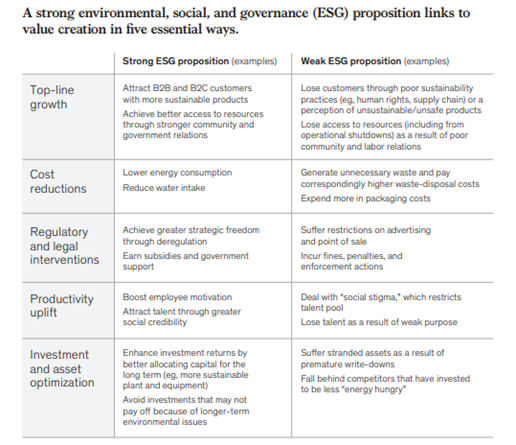
ESG and social value – two sides of the same coin?
While ESG and social value have important differences, forward-thinking organisations are acknowledging how they complement one another, says Thrive’s Neil Macdonald.
In barely 20 years, environmental, social, and governance (ESG) has come to dominate financial thinking. This is clearly a cause for celebration and the fact that markets and investors favour responsible companies is hugely welcome. However, there is a growing sense that ESG fails to account for important parts of what the corporate world could be doing – and often is doing – to create positive benefits.
So, it’s time to ask: “Could social value fill in those gaps?”
ESG – compliance and preventing negative impacts
ESG has evolved from a finance and investment perspective into a methodology for investors to identify businesses that take action to mitigate the negative effects of their activities.
This evolution has seen a huge increase in the popularity of ESG investing, with ESG funds accounting for $30 trillion of assets under management worldwide. This increase is not exclusively driven by the desire to “do good” in the world. There are many good reasons to expect firms with strong ESG propositions to outperform others financially, as the extract below from the 2019 McKinsey report, Five ways that ESG creates value, shows.

There are many different ESG frameworks in use around the world. This wide range of standards, inconsistent reporting and a lack of transparent monitoring has led to concerns that some businesses see it as a way of ‘greenwashing’ their activities for PR purposes rather than either creating real business value or making significant contributions to the environment or society.
One thing that all ESG approaches have in common is a tendency to view that harm-minimisation objective in terms of compliance, rules, and policies, rather than positive contributions made. And yet, businesses have the potential to do much more than just avoid harm.
There is also a growing school of thought in ESG circles that the ‘S’ social pillar has been neglected relative to the others. Social harm or wellbeing is far harder to define and quantify, and – unlike, say, reducing carbon emissions – it is almost always specific to time and place.
For these reasons and more, ESG’s limitations are becoming harder and harder to ignore.
Social value – creating positive value
Social value has a completely different starting point in the UK. Today’s concept has evolved out of efforts to improve public procurement that began with the Public Services (Social Value) Act 2012. Under the most recent update to the law – PPN06/20 – a weighting of at least 10% must be applied to social value benefits in awarding large public contracts.
“Social value provides a framework for quantifying and ascribing a value to the positive effects that good design, reduced pollution and greater energy efficiency have on the lives of individuals and communities.”
This history means that social value thinking has historically differed from ESG thinking in two fundamental ways. Firstly, social value has often been focused on specific project outcomes. Secondly, it is concerned first and foremost with positive value creation – social value undertakings in project bids must always be additional to what would have been achieved anyway.
There is, of course, a lot of crossover between ESG and social value. ESG has long been concerned with supply chain management, employee rights and working practices, stakeholder engagement etc – all of which are cited in the government’s Social Value Model as important indicators of a project’s value-add.
However, it has long been far harder to ascribe clear values to ‘soft’ targets like this than more obviously quantifiable ones. There has also been the matter of priorities. For example, construction and real estate account for around 40% of global energy consumption. As such, the environmental pillar has been at the forefront of the ESG debate in the built environment sector.
As attention turns to the ‘S’ pillar and the debate moves on from reducing negatives to creating positive value, many eyes are looking to the model social value provides.
Are ESG and social value converging?
Just as ESG developed out of earlier understandings of corporate social responsibility, I think we will see further evolution of the concept to better incorporate positive value creation and specific outcomes.
Investors today are looking beyond compliance-based ESG and social value offers a blueprint of how that could develop. To look at construction and infrastructure again, social value provides a framework for quantifying and ascribing a value to the positive effects that good design, reduced pollution and greater energy efficiency have on the lives of individuals and communities. Rather than simply ticking the compliance boxes, practitioners can focus on both organisation-wide and project-specific improvements from their work.
This should appeal even to the most single-mindedly financially-driven investor, because markets have a long history of accounting for intangible ‘goodwill’ in company valuations. The good a business does – the jobs it creates, the community projects it helps to fund, etc – do far more for goodwill than the harm it avoids.
Neil Macdonald is the chief executive of Thrive, the online software platform for capturing community investment, employee volunteering and social value impact.
End.
Green Infrastructure Week curates’ content from the entire ecosystem around green infrastructure from government and NGOs to respected commentators. We are partners with Infrastructure Intelligence who has supplied this article.
Feel free to share this content with your social media community using #GreenInfrastructureWeek
During Green Infrastructure Week we will host a programme of live and exclusive free-to-attend webinars. Stay in touch with event updates by registering here.